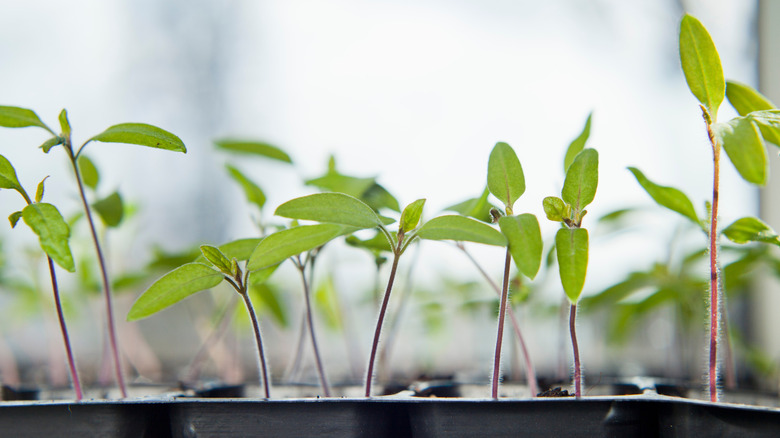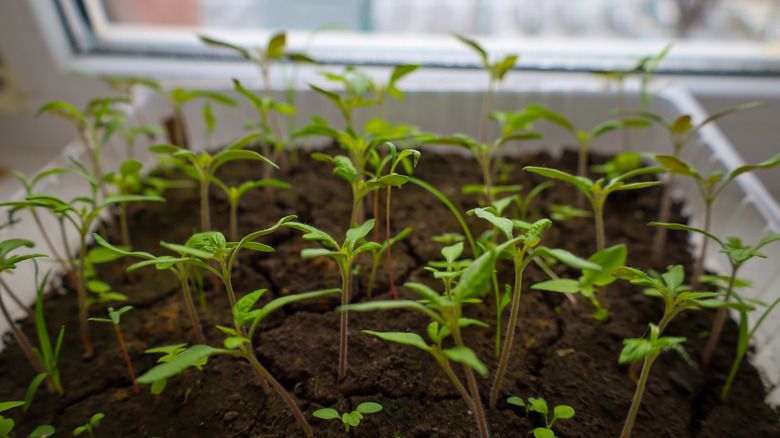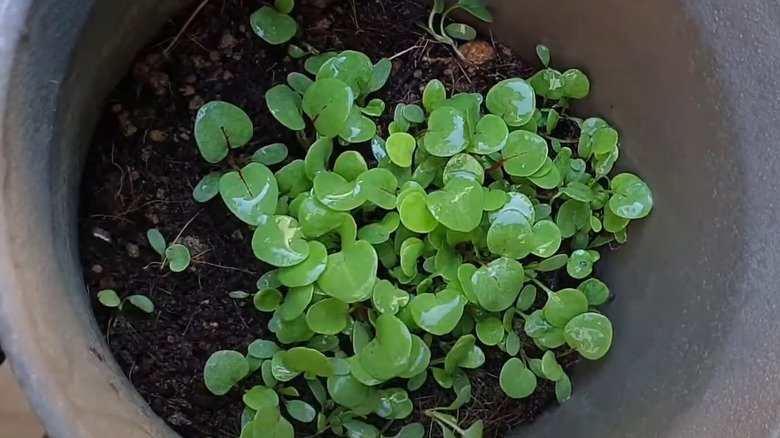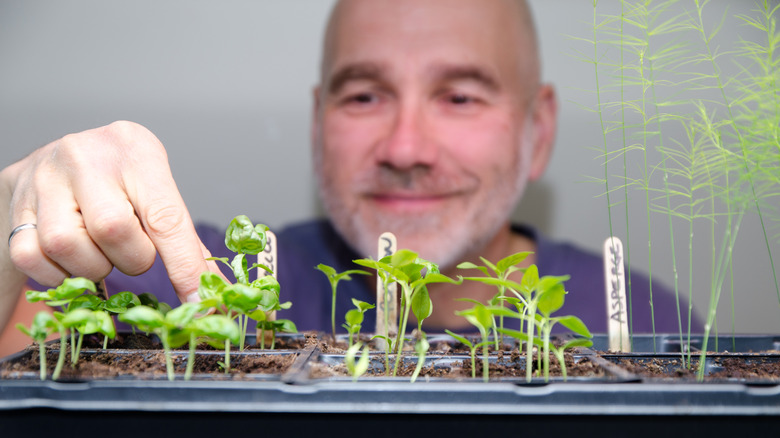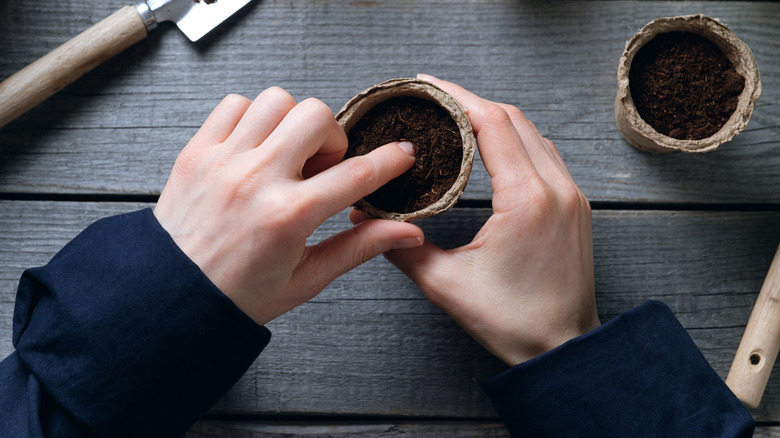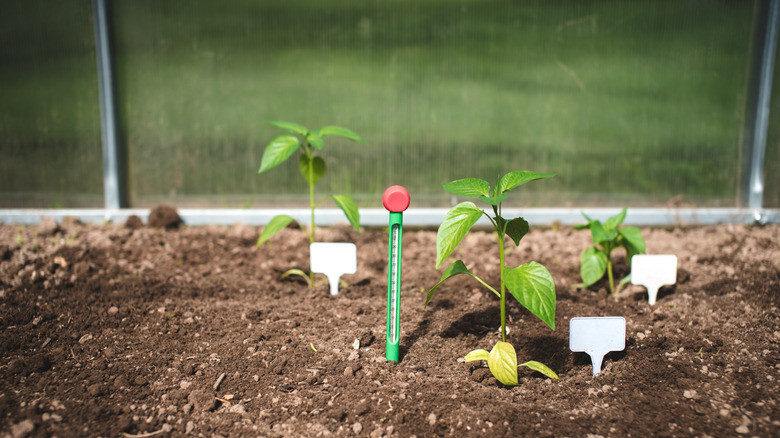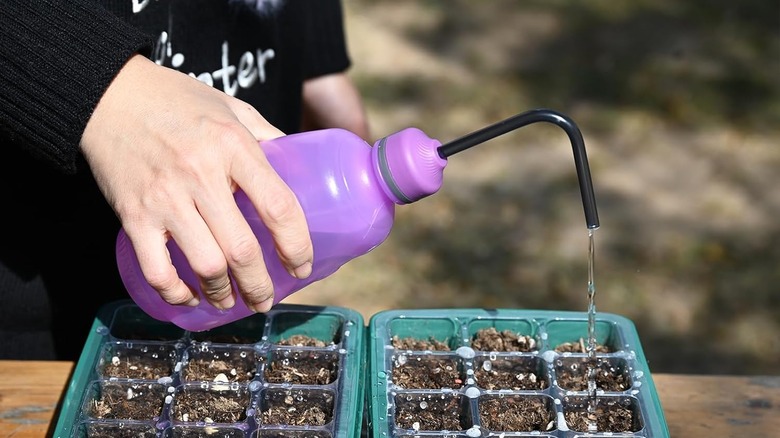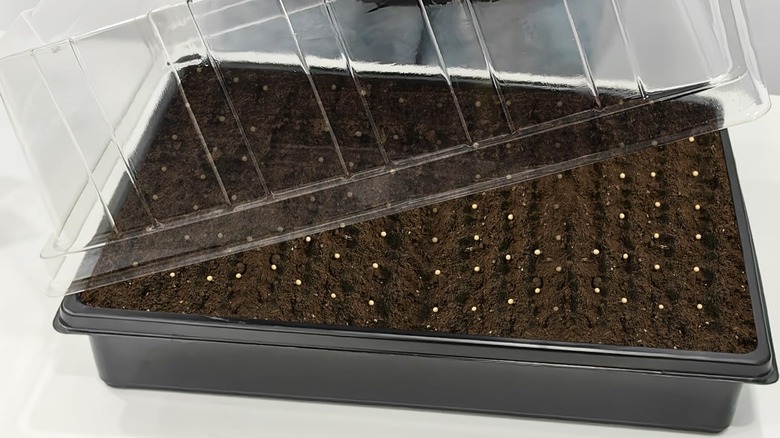Common Mistakes That Are Causing Leggy Seedlings (& What To Do About It)
We may receive a commission on purchases made from links.
Growing indoor or outdoor plants isn't for the faint of heart. It's challenging to tend to plants at any age, and starting them from seeds takes even more precise work as new seedlings are less forgiving of substandard conditions. One of the biggest issues many gardeners encounter is unintentionally growing leggy seedlings with weak stems and sparse leaf growth.
Keep in mind that when plants grow too long, it's not just an issue for aesthetic reasons. Leggy seedlings look neglected and bare compared to properly grown plants because they aren't getting the right amount of sunlight, space, nutrition, or other important elements. The lack of sustenance can make them weaker overall, meaning that they may be more susceptible to diseases, output less fruit, vegetables, or nuts, and have smaller flower blooms. So, it's important to understand the common culprits behind leggy growth and how to fix them. Even if your plants are beyond fixable, you can change up the cultivation process on the next try. So, learn from these common mistakes people make when starting seeds indoors or outdoors that lead to leggy and weak growth.
Plants without enough light desperately reach for light sources
A lack of sunlight is a very common culprit behind leggy seedlings. When light is insufficient, seedlings grow toward whatever they can get, which causes them to reach for windows and around shaded areas. This is especially common in windowsill plants since they only get sunlight from one direction for a portion of the day. Light traveling through windows may be filtered by the window sealant or film, and may also be impeded by window coverings like blinds or curtains. Sunlight becomes even more insufficient in late winter because days can be shorter, and UV rays are indirect due to the angle of the Earth. Recognizing insufficient light is more obvious than other issues since seedlings will angle towards the closest light source. The new growth often turns a pale green to yellow shade.
There are several solutions to this throughout the growing process. Try moving seedlings to windows with better light or transport them outdoors if the weather allows. Another option is to invest in LED grow lights. A design like SunBlaster's Full Spectrum LED Strip Light is good for multiple plants while Xuligron Clip On Grow Light is perfect for illuminating individual pots.
Overcrowding seedlings causes them to compete for sunlight and space
Putting too many seedlings too close together in the soil leads to overcrowding. Too many roots, stems, and leaves get condensed together, making it difficult for plants to grow full and healthy. They're also forced to compete for light, which leads to legginess as they attempt to outgrow one another. This commonly occurs when dropping too many seedlings into a single cell in a plant tray, in an undersized pot, or even in ground plots with limited space and no division between plants.
Other signs your seedlings are overcrowded are easy to spot. The stems tangle around each other, and the strongest stems tower above the surrounding growth. It creates a mess of seedlings, and the tallest ones may be doing better than their neighbors, but they still aren't as healthy as they could be with a little thinning.
To prevent overcrowding, only plant the recommended number of seeds per cell and ensure they're spaced apart according to planting recommendations. Thin out the seedlings when they begin sprouting, leaving one or two healthy plants in a single cell. If you're planting directly in the ground or in a raised bed, use the triangle method seedling hack to make sure plants are evenly spaced apart. There are a few plants with tiny seeds that you can always expect to thin, including vegetables like arugula, carrots, cucumbers, kale, and lettuce.
Not pinching back new growth to encourage healthier growth
Cutting a young seedling might seem counterproductive, but pinching them back can encourage fuller growth. However, one caveat is that you can't perform this hack too early or too late. Pruning them too early can be detrimental to survival while trimming too late can't change an already-established long and thin base stem. This can affect future health, flowering, and fruit production.
If your seeds came in a seed packet, hold onto the empty sleeve or take a picture with your phone. It may have directions on the back of it for pinching back specific plant species. For example, snapdragons need to be pinched back about 1.5 to 2 inches once they reach 3 to 4 inches tall. Many gardeners use their fingers since the stems are soft and easy to break off. If you want to be extra cautious and ensure a clean and hygienic cut, use a sterilized tool, like the iPower 6.5-inch Gardening Scissors Hand Pruner. Cut directly above the first stem node, or set of leaves, giving the plant a healthy spot to branch off of.
Over-fertilizing seedlings with nitrogen can cause legginess
One of the most common mistakes people make when fertilizing a garden is over-feeding seedlings. Excessive amounts of nitrogen, one of the most important nutrients in NPK fertilizer that keeps plants healthy, comes from more than just fertilizer, making it easy to overdose. Nitrogen is also found in decomposing organic materials, water, pre-existing soil particles, and the atmosphere. The burst of nutrients causes seedlings to outgrow their space with long and spindly growth. It also burns smaller roots and makes it difficult for them to absorb phosphorus.
Refrain from using too much fertilizer by paying attention to seedlings' needs and fertilizer requirements. Young plants are more sensitive to fertilizer and benefit better from balanced formulas. So, use a water-soluble type, start with a low concentration when seedlings first sprout, and only apply it every other week. There is no best fertilizer routine that works for all plants, and the quantity and frequency should be adjusted based on how seedlings respond.
Also, consider what soil you started with. A starter soil mix with premixed nutrients may not need additional fertilizer for several months. However, a starter mix that is nutrient-free, such as a peat moss and perlite mix, requires fertilizer as soon as foliage begins sprouting. Try the Espoma Organic Grow! Liquid Concentrate Plant Food, being sure to follow the included instructions for diluting it and applying it to seedlings.
High temperatures make plant stems grow without leaves
Temperature is one of the many exterior factors affecting plant growth, and when heat levels are too high, they have negative consequences. All plant species have specific soil temperature needs that must be met for them to germinate, usually between 68 and 86 degrees Fahrenheit. Once sprouted, the ideal temperature drops by about 10 degrees Fahrenheit as seedlings favor milder temperatures in the early growth stages. However, excessive heat can make them shoot up quickly but with weak growth, leading to long and leggy stems.
The best way to avoid this situation is to ensure that plants have their temperature needs met. Look for a chart for your specific plants, like Oregon State University's vegetable seed germination list, to identify what range is ideal for the species you intend to grow. Then, pick up a thermometer like the AikTryee Mini Hygrometer Thermometer to know the exact temperature (and humidity) of your growing environment. Then, adjust the conditions as needed to give your plants the best start.
Improper watering hinders growth or causes bursts of growth that makes seedlings leggy
Watering is one of the most important steps of plant care, and both overwatering and underwatering lead to issues like legginess. When seedlings are rarely watered, they have strong reactions when they do get moisture. This can lead to accelerated growth and leggy stems. On the other hand, overwatering can make stems leggy as soaked roots can't intake enough oxygen and nutrients.
Watering correctly is super important, but there is no exact amount that works for every plant. All seedlings have different needs based on the species, climate, soil, and sunlight exposure. Starting seeds in trays or pots and transplanting them later keeps them in a more controlled environment that is easier to monitor throughout the first few weeks. Mist seeds to start their germination without overwatering from the get-go. Once they begin sprouting, soak them from the bottom up. Set the pots or tray in a larger bin of water and wait for the topmost layer of soil to turn dark from moisture. Check their status every morning, and if the top half-inch of soil feels dry, it's due for another watering. Fortunately, it's possible to take some of the guesswork out of this routine by ordering a Self-Watering Seed Starter Tray that helps moderate water absorption.
Inadequate ventilation keeps seedlings from forming a sturdy base
Spacing plants is important for more reasons than preventing overcrowding after germination. They need ventilation and air circulation to form a strong base to support growing stems and leaves. When wind hits plants, it releases auxin hormones, which trigger stronger stem growth. Ensuring they have proper air circulation provides plenty of space to develop wide and tall stems instead of a feeble, spindly form. Air circulation also helps keep bacteria, fungus, and mold growth at bay in moist seedling environments, which in turn prevents common illnesses and diseases.
Ensure seedlings have space for ventilation prior to sprouting. Many people use a domed seed starter. This is helpful early on for retaining moisture and humidity but should be removed when the first stems and leaves appear to enable good airflow. Set up a small desktop fan like Amazon Basics Air Circulator Fan to gently blow air around the seedlings, encouraging robust growth early on. Although this fan is intended for desk and office spaces, some reviewers report using it for their plants. One customer stated, "I got this to add a little circulation to my house plants and keep their stems strong," leaving a five-star rating for its effectiveness.
